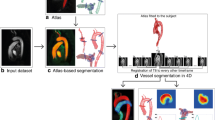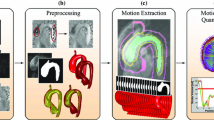Abstract
Purpose
Quantitative analysis of vascular blood flow, acquired by phase-contrast MRI, requires accurate segmentation of the vessel lumen. In clinical practice, 2D-cine velocity-encoded slices are inspected, and the lumen is segmented manually. However, segmentation of time-resolved volumetric blood-flow measurements is a tedious and time-consuming task requiring automation.
Methods
Automated segmentation of large thoracic arteries, based solely on the 3D-cine phase-contrast MRI (PC-MRI) blood-flow data, was done. An active surface model, which is fast and topologically stable, was used. The active surface model requires an initial surface, approximating the desired segmentation. A method to generate this surface was developed based on a voxel-wise temporal maximum of blood-flow velocities. The active surface model balances forces, based on the surface structure and image features derived from the blood-flow data. The segmentation results were validated using volunteer studies, including time-resolved 3D and 2D blood-flow data. The segmented surface was intersected with a velocity-encoded PC-MRI slice, resulting in a cross-sectional contour of the lumen. These cross-sections were compared to reference contours that were manually delineated on high-resolution 2D-cine slices.
Results
The automated approach closely approximates the manual blood-flow segmentations, with error distances on the order of the voxel size. The initial surface provides a close approximation of the desired luminal geometry. This improves the convergence time of the active surface and facilitates parametrization.
Conclusions
An active surface approach for vessel lumen segmentation was developed, suitable for quantitative analysis of 3D-cine PC-MRI blood-flow data. As opposed to prior thresholding and level-set approaches, the active surface model is topologically stable. A method to generate an initial approximate surface was developed, and various features that influence the segmentation model were evaluated. The active surface segmentation results were shown to closely approximate manual segmentations.
Similar content being viewed by others
References
Ahlberg J (1996) Active contours in three dimensions. PhD thesis, Linköping University
American Heart Association (2010) Heart disease and stroke statistics. http://www.americanheart.org/statistics. Accessed 13 July 2011
Chung ACS, Noble JA, Summers P (2004) Vascular segmentation of phase-contrast magnetic resonance angiograms based on statistical mixture modeling and local phase coherence. IEEE Trans Med Imaging 23(12): 1490–1507
Granlund GH, Knutsson H (1995) Signal Processing for Computer Vision
Hautvast GLTF, Lobregt S, Breeuwer M, Vilanova A, Gerritsen FA (2005) Automatic contour detection in short-axis cardiac cine MR data. J Cardiovasc Magn Reson 7(1): 323–324
Hennemuth A, Friman O, Schumann C, Bock J, Drexl J, Huellebrand M, Markl M, Peitgen HO (2011) Fast interactive exploration of 4D MRI flow data. In: Proceedings of SPIE, vol 7964, pp 79640E-1—79640E-11
Lorensen WE, Cline HE (1987) Marching cubes: a high resolution 3D surface construction algorithm. Comput Graph Interact Tech 21(4): 163–169
Markl M, Draney MT, Hope MD, Levin JM, Chan FP, Alley MT, Pelc NJ, Herfkens RJ (2005) Time-resolved 3-dimensional velocity mapping in the thoracic aorta: visualization of 3-directional blood flow patterns in healthy volunteers and patients. J Comput Assist Tomogr 28(4): 459–468
Markl M, Kilner PJ, Ebbers T (2011) Comprehensive 4D velocity mapping of the heart and great vessels by cardiovascular magnetic resonance. J Cardiovasc Magn Reson 13(7): 1–22
Nguyen TQH (2010) Automated blood-flow segmentation in large thoracic arteries using 4D MRI flow measurements. MSc thesis, Eindhoven University of Technology
Persson M, Solem JE, Markenroth K, Svensson J, Heyden A (2005) Phase contrast MRI segmentation using velocity and intensity. Scale Space PDE Methods Comput Vis 3459: 119–130
Solem JE, Persson M, Heyden A (2004) Velocity based segmentation in phase-contrast MRI images. Med Image Comput Comput Assist Interv (MICCAI) 3216: 459–466
Uribe S, Tangchaoren T, Parish V, Wolf I, Razavi R, Greil G, Schaeffter T (2008) Volumetric cardiac quantification by using 3D dual-phase whole-heart MR imaging. Radiology 248(2): 606–614
van Assen HC, Danilouchkine MG, Dirksen MS, Reiber JHC, Lelieveldt BPF (2008) A 3D active shape model driven by fuzzy inference: application to cardiac CT and MR. IEEE Trans Inf Technol Biomed 12(5): 595–605
van Pelt R, Bescòs JO, Breeuwer M, Clough RE, Gröller ME, ter Haar Romeny B, Vilanova A (2010) Exploration of 4D MRI blood flow using stylistic visualization. IEEE Trans Vis Comput Graph 16(4): 1339–1347
The Visualization Toolkit. http://vtk.org. Accessed 13 July 2011
Author information
Authors and Affiliations
Corresponding author
Rights and permissions
About this article
Cite this article
van Pelt, R., Nguyen, H., ter Haar Romeny, B. et al. Automated segmentation of blood-flow regions in large thoracic arteries using 3D-cine PC-MRI measurements. Int J CARS 7, 217–224 (2012). https://doi.org/10.1007/s11548-011-0642-9
Received:
Accepted:
Published:
Issue Date:
DOI: https://doi.org/10.1007/s11548-011-0642-9




